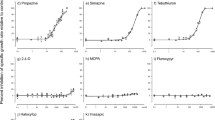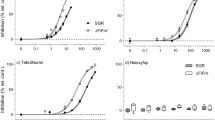Abstract
Aquatic organisms are typically exposed to fluctuating concentrations of herbicides in streams. To assess the effects on algae of repeated peak exposure to the herbicide isoproturon, we subjected the alga Scenedesmus vacuolatus to two sequential pulse exposure scenarios. Effects on growth and on the inhibition of the effective quantum yield of photosystem II (PSII) were measured. In the first scenario, algae were exposed to short, 5-h pulses at high isoproturon concentrations (400 and 1000 μg/l), each followed by a recovery period of 18 h, while the second scenario consisted of 22.5-h pulses at lower concentrations (60 and 120 μg/l), alternating with short recovery periods (1.5 h). In addition, any changes in the sensitivity of the algae to isoproturon following sequential pulses were examined by determining the growth rate-EC50 prior to and following exposure. In both exposure scenarios, we found that algal growth and its effective quantum yield were systematically inhibited during the exposures and that these effects were reversible. Sequential pulses to isoproturon could be considered a sequence of independent events. Nevertheless, a consequence of inhibited growth during the repeated exposures is the cumulative decrease in biomass production. Furthermore, in the second scenario, when the sequence of long pulses began to approach a scenario of continuous exposure, a slight increase in the tolerance of the algae to isoproturon was observed. These findings indicated that sequential pulses do affect algae during each pulse exposure, even if algae recover between the exposures. These observations could support an improved risk assessment of fluctuating exposures to reversibly acting herbicides.



Similar content being viewed by others
References
Baker NR, Bowyer JR (1994) Photoinhibition of photosynthesis: from molecular mechanisms to the field. Bios Scientific, Oxford
Balsiger C, Niederhauser P, Jäggi O, Meier W (2007) Gewässerbelastung durch Pestizide. Gaz Wasser Abwasser (GWA) 3:177–185
Behra R, Genoni GP, Joseph AL (1999) Effect of atrazine on growth, photosynthesis, and between-strain variability in Scenedesmus subspicatus (Chlorophyceae). Arch Environ Contam Toxicol 37:36–41. doi:10.1007/s002449900487
Berenzen N, Lentzen-Godding A, Probst M, Schulz H, Schulz R, Liess M (2005) A comparison of predicted and measured levels of runoff-related pesticide concentrations in small lowland streams on a landscape level. Chemosphere 58:683–691. doi:10.1016/j.chemosphere.2004.05.009
Blanck H (2002) A critical review of procedures and approaches used for assessing pollution-induced community tolerance (PICT) in biotic communities. Hum Ecol Risk Assess 8:1003–1034. doi:10.1080/1080-700291905792
Cedergreen N, Andersen L, Olesen CF, Spliid HH, Streibig JC (2005) Does the effect of herbicide pulse exposure on aquatic plants depend on K-ow or mode of action? Aquat Toxicol 71:261–271. doi:10.1016/j.aquatox.2004.11.010
Chèvre N, Loepfe C, Singer H, Stamm C, Fenner K, Escher B (2006) Including mixtures in the determination of water quality criteria for herbicides in surface water. Env Sci Technol 40:426–435
Devine MD, Duke SO, Fedtke C (1993) Physiology of herbicide action. Prentice Hall, Englewood Cliffs, NJ
Drost W, Backhaus T, Vassilakaki M, Grimme LH (2003) Mixture toxicity of s-triazines to Lemna minor under conditions of simultaneous and sequential exposure. Fresenius Environ Bull 12:601–607
Garmouma M, Teil MJ, Blanchard M, Chevreuil M (1998) Spatial and temporal variations of herbicide (triazines and phenylureas) concentrations in the catchment basin of the Marne river (France). Sci Total Environ 224:93–107. doi:10.1016/S0048-9697(98)00326-X
Gustavson K, Mohlenberg F, Schluter L (2003) Effects of exposure duration of herbicides on natural stream periphyton communities and recovery. Arch Environ Contam Toxicol 45:48–58. doi:10.1007/s00244-002-0079-9
Klaine SJ, Richards P, Baker D, Naddy R, Brown T, Joab B, Casey R, Fernandez D, Overmeyer J, Benjamin R (1997) Agrochemical fate and effects in terrestrial, aquatic and estuarine ecosystems. Environmental Behavior of Crop Protection Chemicals, International Atomic Energy Agency, Vienna, Austria, pp 247–263
Kreuger J (1998) Pesticides in stream water within an agricultural catchment in southern Sweden, 1990–1996. Sci Total Environ 216:227–251. doi:10.1016/S0048-9697(98)00155-7
Le Faucheur S, Behra R, Sigg L (2005) Phytochelatin induction, cadmium accumulation, and algal sensitivity to free cadmium ion in Scenedesmus vacuolatus. Environ Toxicol Chem 24:1731–1737. doi:10.1897/04-394R.1
Leu C (2003) Sources, processes and factors determining the losses of atrazine, dimethenamid and metolachlor to surface waters: a simultaneous assessment in six agriculture catchments. Eidgenössische Technische Hochschule Zürich (ETHZ), Zurich, Switzerland
Macinnis-Ng CMO, Ralph PJ (2004) In situ impact of multiple pulses of metal and herbicide on the seagrass, Zostera capricorni. Aquat Toxicol 67:227–237. doi:10.1016/j.aquatox.2004.01.012
Maxwell K, Johnson GN (2000) Chlorophyll fluorescence—a practical guide. J Exp Bot 51:659–668. doi:10.1093/jexbot/51.345.659
Muller K, Bach M, Hartmann H, Spiteller M, Frede H-G (2002) Point- and nonpoint-source pesticide contamination in the Zwester ohm catchment, Germany. J Environ Qual 31:309–318
Peres F, Florin D, Grollier T, FeurtetMazel A, Coste M, Ribeyre F, Ricard M, Boudou A (1996) Effects of the phenylurea herbicide isoproturon on periphytic diatom communities in freshwater indoor microcosms. Environ Pollut 94:141–152. doi:10.1016/S0269-7491(96)00080-2
Rensen JJS (1982) Molecular mechanisms of herbicide action near photosystem II. Plant Physiol 54:515–521
Reinert KH, Giddings JA, Judd L (2002) Effects analysis of time-varying or repeated exposures in aquatic ecological risk assessment of agrochemicals. Environ Toxicol Chem 21:1977–1992. doi :10.1897/1551-5028(2002)021<1977:EAOTVO>2.0.CO;2
Rutherford AW, Krieger-Liszkay A (2001) Herbicide-induced oxidative stress in photosystem II. Trends Biochem Sci 26:648–653. doi:10.1016/S0968-0004(01)01953-3
Schmitt-Jansen M, Altenburger R (2005a) Toxic effects of isoproturon on periphyton communities—a microcosm study. Estuar Coast Shelf Sci 62:539–545. doi:10.1016/j.ecss.2004.09.016
Schmitt-Jansen M, Altenburger R (2005b) Predicting and observing responses of algal communities to photosystem II—herbicide exposure using pollution-induced community tolerance and species-sensitivity distributions. Environ Toxicol Chem 24:304–312. doi:10.1897/03-647.1
Schreiber U, Muller JF, Haugg A, Gademann R (2002) New type of dual-channel PAM chlorophyll fluorometer for highly sensitive water toxicity biotests. Photosynth Res 74:317–330. doi:10.1023/A:1021276003145
Stoob K, Singer HP, Goetz CW, Ruff M, Mueller SR (2005) Fully automated online solid phase extraction coupled directly to liquid chromatography-tandem mass spectrometry—quantification of sulfonamide antibiotics, neutral and acidic pesticides at low concentrations in surface waters. J Chromatogr A 1097:138–147. doi:10.1016/j.chroma.2005.08.030
Vallotton N, Eggen RIL, Escher BI, Krayenbuhl J, Chevre N (2008a) Effect of pulse herbicidal exposure on Scenedesmus vacuolatus: a comparison of two photosystem II inhibitors. Environ Toxicol Chem 27:1399–1407. doi:10.1897/07-197.1
Vallotton N, Moser D, Eggen RIL, Junghans M, Chèvre N (2008b) S-metolachlor pulse exposure on the alga Scenedesmus vacuolatus: effect during exposure and the subsequent recovery. Chemosphere (in press)
Acknowledgments
This work was funded by Swiss National Research Foundation Grant 200021-109569/1. The authors thank Alfred Lück of the Department of Environmental Chemistry, Zachariah Schreiber, and the anonymous reviewers.
Author information
Authors and Affiliations
Corresponding author
Rights and permissions
About this article
Cite this article
Vallotton, N., Eggen, R.I.L. & Chèvre, N. Effect of Sequential Isoproturon Pulse Exposure on Scenedesmus vacuolatus . Arch Environ Contam Toxicol 56, 442–449 (2009). https://doi.org/10.1007/s00244-008-9200-z
Received:
Accepted:
Published:
Issue Date:
DOI: https://doi.org/10.1007/s00244-008-9200-z




